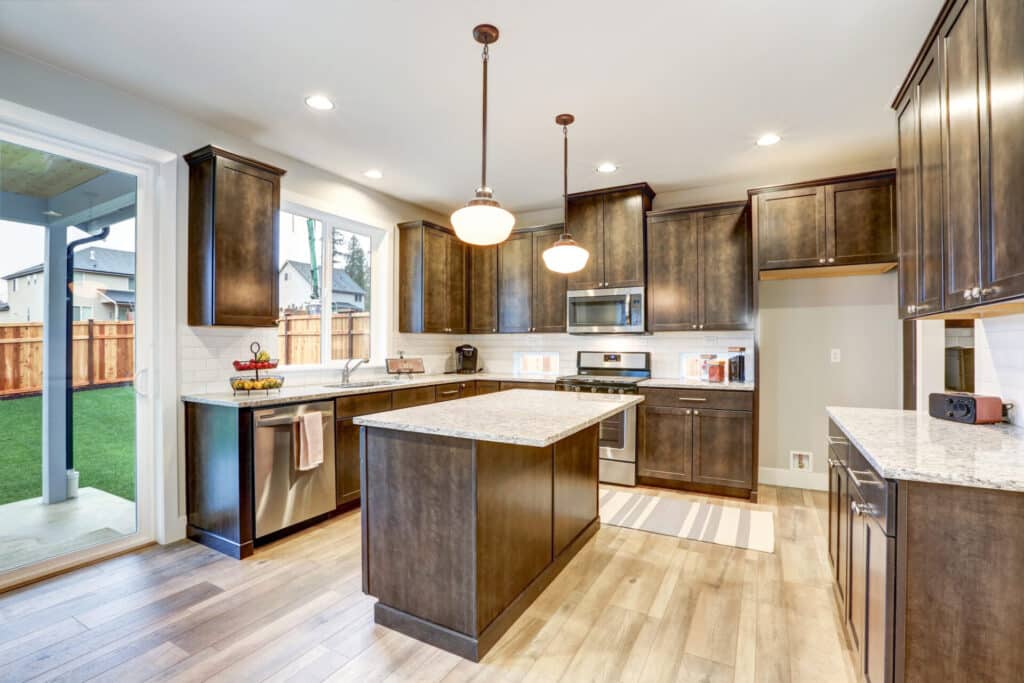
Choosing a kitchen backsplash that complements your countertop is an important decision. The backsplash not only protects your walls from spills and splashes but it also adds a focal point and enhances the overall visual appeal of your kitchen. With countless options available, it can be overwhelming to decide which backsplash material, color, and pattern will best match your countertop. To help you make an informed decision, we have curated a guide on how to choose a kitchen backsplash to match your countertop.
Consider the Overall Style
Before diving into the specifics, it’s essential to consider the overall style of your kitchen. Are you going for a sleek and modern look, a rustic farmhouse feel, or a traditional and classic design? This will serve as a foundation for selecting the right backsplash materials and colors that will harmonize with your countertop.
Read: What Backsplash Does Not Go Out Of Style?
Match the Colors
When choosing a backsplash, it’s important to pay attention to the color scheme and undertones of your countertop. Matching or complementing the colors will create a cohesive and visually pleasing look. Here are some tips for color matching:
1. Neutral Colors:
If your countertop is in a neutral color, such as white, gray, or beige, you have the flexibility to choose from a wide range of backsplash options. You can go for a monochromatic look by selecting a backsplash that is the same color as your countertop. This will create a seamless and sophisticated appearance. Alternatively, add depth and interest by choosing a slightly different shade of the same color. For example, if you have a sandy beige countertop, a cream-colored subway tile backsplash would complement it beautifully.
2. Contrasting Colors:
Creating contrast between your countertop and backsplash can make a bold statement and add visual interest. For example, if you have a dark countertop in shades of brown or black, consider pairing it with a light-colored backsplash. A white subway tile backsplash against a dark countertop will create a striking contrast. You can also experiment with complementary colors. For instance, a deep blue countertop can be paired with a copper or orange-toned backsplash to create a vibrant and eye-catching design.
3. Harmonizing Colors:
If you prefer a more harmonious and cohesive look, opt for a backsplash that has the same undertones as your countertop. Undertones refer to the underlying colors that are present in your countertop or backsplash material. For example, if your countertop has warm undertones, such as yellow or brown, choose a backsplash that also has warm undertones. This will create a sense of unity between the two surfaces.
Consider Material Compatibility
When choosing a kitchen backsplash, it’s not only the color that matters but also the material. The material should be durable enough to withstand regular exposure to moisture, heat, and cooking residue. Here are some popular backsplash materials and their compatibility with different countertop materials:
1. Tile:
Tiles are a popular choice for backsplashes due to their versatility and wide range of options. Ceramic and porcelain tiles are durable and resistant to heat and moisture, making them ideal for kitchens. They are available in various sizes, shapes, colors, and patterns, allowing you to find the perfect match for your countertop. Glass tiles are also a great option for creating a sleek and modern look. When choosing tile backsplash, consider the size and shape of the tiles and how they will complement the pattern and style of your countertop.
2. Stone:
Stone backsplashes, such as granite or marble, can create a luxurious and elegant look. These materials offer durability and unique natural beauty. When choosing a stone backsplash, try to match the patterns and colors of the stone with those on your countertop for a cohesive look. However, keep in mind that natural stones require sealing to protect them from stains and spills.
3. Stainless Steel:
If you have a stainless steel countertop, a stainless steel backsplash can create a seamless and industrial look. It offers durability and is easy to clean. However, too much stainless steel in the kitchen can create a cold and sterile atmosphere, so consider adding warmth by using other materials or incorporating pops of color.
4. Solid Surface or Quartz:
Solid surface and quartz countertops are popular choices for their durability, low maintenance, and wide range of colors and patterns. These materials can be easily paired with a variety of backsplash materials, such as ceramic or glass tiles, for a customized look. When selecting a backsplash for these countertops, take into account the overall color palette and style of your kitchen.
Evaluate the Lighting
Lighting plays a crucial role in how your kitchen backsplash and countertop appear. Natural and artificial light can greatly affect the colors and textures of both surfaces. Before finalizing your selection, observe how the lighting in your kitchen interacts with your countertop. Consider the following factors:
1. Natural Light:
If you have abundant natural light in your kitchen, it will bring out the true colors of your countertop and backsplash. Take advantage of this by selecting materials and colors that you love, as they will be showcased in their most vibrant form.
2. Artificial Light:
Different types of artificial lighting can cast different warm or cool tones. Fluorescent lighting tends to have a bluish tone, whereas incandescent lighting casts a warmer yellowish hue. LED lighting can vary in color temperature, offering options from warm to cool whites. Consider the lighting in your kitchen when choosing a backsplash material and color, as it will affect how they appear under different lighting conditions.
3. Backlit Backsplash:
If you want to create a focal point in your kitchen, consider installing a backlit backsplash. This can be achieved with materials such as onyx or glass. The backlighting will add a stunning visual element and enhance the colors and patterns of your countertop.
Balance Visual Texture
The texture of your countertop and backsplash can create a sense of depth and visual interest in your kitchen. Consider the following tips for balancing visual texture:
1. Smooth Countertops:
If you have a smooth and sleek countertop, such as quartz or granite, you can add visual texture with a backsplash. Consider using textured materials like subway tiles with a raised pattern, mosaic tiles with different finishes, or even a brick or stone veneer to introduce a tactile element.
2. Textured Countertops:
If your countertop already has a lot of texture, such as a natural stone like slate or travertine, consider a smoother and simpler backsplash to create a balanced look. This will prevent your kitchen from appearing too busy or overwhelming with competing textures.
3. Harmonizing Textures:
If you prefer a cohesive look, opt for a countertop and backsplash that have similar textures. For example, a polished granite countertop can be paired with a polished granite or glass tile backsplash to create a harmonious and sophisticated design.
Seek Professional Advice
If you are still unsure about which backsplash will best match your countertop, consider seeking advice from a professional designer or a kitchen remodeling company. They can provide insights and suggestions based on their expertise and experience. Additionally, they may be able to show you samples and mockups to help visualize how different combinations will look in your kitchen.
Read: How Much Does It Cost To Install A Kitchen Backsplash?
Choosing a kitchen backsplash that matches your countertop is an important decision that can greatly enhance the aesthetics of your kitchen. By considering the overall style, matching colors, evaluating material compatibility, assessing the lighting, balancing visual texture, and seeking professional advice, you can make an informed decision and create a cohesive and visually pleasing kitchen design. Remember to take your time, explore different options, and choose a backsplash that not only complements your countertop but also reflects your personal style and taste.
